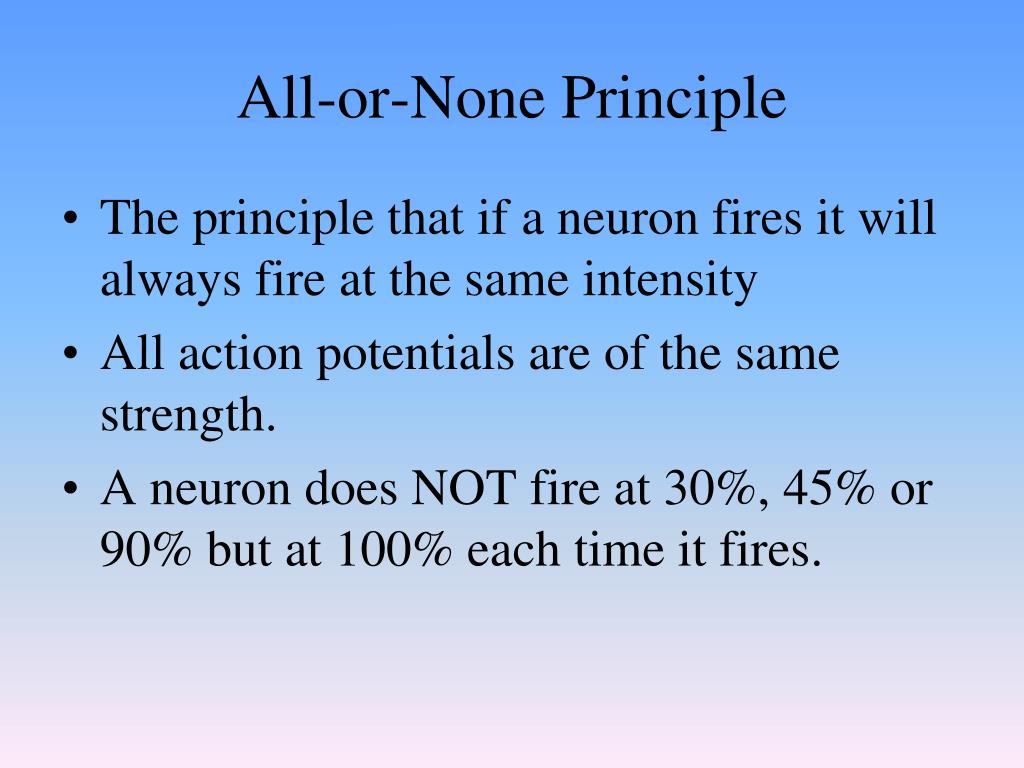
What is the all or none law of the heart?Īll-or-none law, a physiological principle that relates response to stimulus in excitable tissues. When these cells decide to respond to a stimulus, they either respond completely or not at all. Neurons are made up of cell bodies, axons, and dendrites, and they line up with small synapses between them. In some neurons, a single action potential can be induced by the offset of a hyperpolarizing stimulus (Fig.ĭoes all or none principle apply to dendrites? The action potential is said to be all-or-nothing because it occurs only for sufficiently large depolarizing stimuli, and because its form is largely independent of the stimulus for suprathreshold stimuli. If that stimulus exceeds the threshold potential, the muscle fiber will give a complete response, otherwise, there is no response. What is all or none principle Class 11?Īll or none law is the principle that states that the strength by which a muscle fiber responds to a stimulus is independent of the strength of the stimulus. What does it mean, that action potentials are all or none? The action potential will be the same size, no matter what the size of the triggering stimulus, as long as threshold is reached. What does it mean to say that action potentials are all-or-none quizlet? For example, a nerve cell is either stimulated to transmit a complete nervous impulse or else it remains in its resting state a stinging …
All or none principle full#
What are some examples of the all or none principle?Ī type of response that may be either complete and of full intensity or totally absent, depending on the strength of the stimulus there is no partial response. What is all or none response kids?Īll-or-none response A type of response that may be either complete and of full intensity or totally absent, depending on the strength of the stimulus there is no partial response. Action potentials are caused when different ions cross the neuron membrane. Therefore, the neuron either does not reach the threshold or a full action potential is fired – this is the “ALL OR NONE” principle. There are no big or small action potentials in one nerve cell – all action potentials are the same size. What does it mean to say that action potentials are all or none? If the stimulus exceeds the threshold potential, the nerve or muscle fiber will give a complete response otherwise, there is no response.

The all-or-none law is the principle that the strength by which a nerve or muscle fiber responds to a stimulus is independent of the strength of the stimulus. What is the all or none principle in psychology quizlet?

If a stimulus is above a certain threshold, a nerve or muscle fiber will fire. The all-or-none law is a principle that states that the strength of a response of a nerve cell or muscle fiber is not dependent upon the strength of the stimulus. What is meant by the all or none principle?

The action potential is always a full response.

Changes in cell polarization result in the signal being propagated down the length of the axon. If a stimulus is strong enough, an action potential occurs and a neuron sends information down an axon away from the cell body and toward the synapse. The All or None principle COLLAPSE Research: The all-or-none law, a physiological principle that relates response to stimulus in excitable tissues.


 0 kommentar(er)
0 kommentar(er)
